The War on Language: Providing Culturally Appropriate Care to Syrian Refugees
DOI:
https://doi.org/10.18192/uojm.v6i2.1544Keywords:
language barriers, refugeesAbstract
ABSTRACT
Ontario’s Ministry of Health and Long-Term Care released a document in January 2016 regarding medical care of Syrian refugees as an effort to support primary care providers in the care and early assessment of their new patients [1]. The fourteen-page document provides an overview of the transition to Ontario medical care, from the Immigration Medical Examination prior to the refugee’s entry into Canada, to health insurance coverage resources and information [1]. Health care providers may welcome this plethora of information, but the presence of a language barrier may prove to be the most considerable issue.
RÉSUMÉ
En janvier 2016, le ministère de la Santé et des Soins de longue durée de l’Ontario a publié un document au sujet des soins médicaux pour les réfugiés syriens, pour appuyer les fournisseurs de soins primaires lorsqu’ils soignent et effectuent l’évaluation initiale de leurs nouveaux patients [1]. Le document de quatorze pages fournit un survol de la transition vers les soins de santé ontariens, allant de l’examen médical aux fins d’immigration précédant l’entrée du réfugié au Canada, à de l’information sur les régimes d’assurance-maladie [1]. Les professionnels de la santé recevront sans doute favorablement cette abondance d’information, mais la présence d’une barrière linguistique pourrait se révéler comme étant le problème le plus substantiel.
References
2. Government of Canada [Internet]. Map of destination communities and ser¬vice provider organizations. Government of Canada; 2015 Nov 9 [updated 2016 Feb 9; cited 2016 Feb 9]. Available from: http://www.cic.gc.ca/eng¬lish/refugees/welcome/map.asp.
3. Woods A, Benzie R [Internet]. Ottawa (ON): Quebec, Ontario ready to ac¬cept 16,000 Syrian refugees, as Saskatchewan balks. Toronto Star; 2015 Nov 16 [updated 2015 Nov 16; cited 2016 Feb 9]. Available from: http://www. thestar.com/news/canada/2015/11/16/quebec-ontario-ready-to-accept- 16000-syrian-refugees-as-saskatchewan-balks.html.
4. Pottie K, Greenaway C, Feightner J, et al. Evidence-based clinical guidelines for immigrants and refugees. Can Med Assoc J. 2011;183(12):824-925
5. Pottie K, Greenaway C, Hassan G, Hui C, Kirmayer LJ [Internet]. Ottawa (ON): Caring for a newly arrived Syrian refugee family. Can Med Assoc J; 2015 Dec 8 [updated 2015 12 8; cited 2016 Feb 9]. Available from: http:// www.cmaj.ca/site/misc/caring-for-a-newly-arrived-syrian-refugee-family-cmaj.151422.xhtml.
6. European Centre for Disease Prevention and Control [Internet]. Sweden: In¬fectious diseases of specific relevance to newly-arrived migrants in the EU/ EEA. 2015 Nov 19 [updated 2015 Nov 19; cited 2016 Feb 9]. Available from: http://ecdc.europa.eu/en/publications/Publications/Infectious-diseases-of-specific-relevance-to-newly-arrived-migrants-in-EU-EEA.pdf.
7. Health Canada [Internet]. Ottawa (ON): Language Barriers in Access to Health Care. 2001 Nov [published 2001 Nov; cited 2016 Feb 9]. Avail¬able from: http://www.hc-sc.gc.ca/hcs-sss/alt_formats/hpb-dgps/pdf/ pubs/2001-lang-acces/2001-lang-acces-eng.pdf.
8. Wang L, Kwak M-J. Immigration, barriers to healthcare and transnational ties: A case study of South Korean immigrants in Toronto, Canada. Soc Sci & Med. 2014;133:340-348.
9. Lebrun LA. Effects of length of stay and language proficiency on health care experiences among Immigrants in Canada and the United States. Soc Sci & Med. 2012; 74:1062-1072.
10. Schenker Y, Wang F, Selig SJ, et al. The impact of language barriers on docu¬mentation of informed consent at a hospital with on-site interpreter ser¬vices. J Gen Intern Med. 2007;22(2):294-299.
11. Saha S, Fernandez A. Language barriers in health care. J Gen Intern Med. 2007;22(2):281-282.
12. Gerrish K. The nature and effect of communication difficulties arising from interactions between district nurses and South Asian patients and their car¬ers. Journal of Advanced Nursing. 2001;33(5):566-574.
13. Gerrish K, Chau R, Sobowale A et al. Bridging the language barrier: the use of interpreters in primary care nursing. Health and Social Care in the Com¬munity. 2004;12(55):407-413.
14. Wang L, Rosenberg M, Lo L. Ethnicity and utilization of family physicians: A case study of Mainland Chinese immigrant in Toronto, Canada. Soc Sci & Med. 2008;67:1410-1422.
15. Gadon M, Balch GI, Jacobs EA. Caring for patients with limited English pro¬ficiency: The perspectives of small group practitioners. J Gen Intern Med. 2006;22[Suppl 2]:341-346.
16. Gushulak BD, Williams LS. National immigrant health policy: Existing policy, changing needs, and future directions. Can J Public Health. 2004;95(3):127- 129.
17. McDonald JT, Kennedy S. Insights into the ‘healthy immigrant effect’: health status and health service se of immigrants to Canada. Soc Sci & Med. 2004;59(8):1613-1627.
18. DesMeules M, Gold J, Kazanjian A et al. New approaches to immigrant health assessment. Can J Public Health. 2004;95(3):122-126
19. Purnell L. The Purnell Model for Cultural Competence. J of Trans Nursing. 2002;13(3):193-196.
20. Purnell LD. Guide to Culturally Competent Health Care. In: Chapter 3 – Barri¬ers to Culturally Competent Health Care. 3rd ed. Philadelphia, PA: F.A. Davis Company; 2014. 22-30 p.
21. Pottie K, Ng E, Spitzer D, et al. Language proficiency, gender and self-report¬ed health. Can J Public Health. 2008;99(6):505-510.
Downloads
Published
Issue
Section
License
- Authors publishing in the UOJM retain copyright of their articles, including all the drafts and the final published version in the journal.
- While UOJM does not retain any rights to the articles submitted, by agreeing to publish in UOJM, authors are granting the journal right of first publication and distribution rights of their articles.
- Authors are free to submit their works to other publications, including journals, institutional repositories or books, with an acknowledgment of its initial publication in UOJM.
- Copies of UOJM are distributed both in print and online, and all materials will be publicly available online. The journal holds no legal responsibility as to how these materials will be used by the public.
- Please ensure that all authors, co-authors and investigators have read and agree to these terms.
- Works are licensed under a Creative Commons Attribution-NonCommercial-NoDerivatives 4.0 International License.


